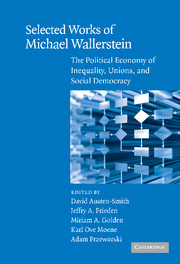 Selected Works of Michael Wallerstein
Selected Works of Michael Wallerstein Published online by Cambridge University Press: 27 January 2010
Ten years ago, when the volume Order and Conflict in Contemporary Capitalism (Goldthorpe 1984) was published, conventional academic wisdom regarding the future of trade unions and corporatism in western Europe was optimistic. As numerous contributors to that earlier volume emphasized, systems of industrial relations involving encompassing unions, in which authority was concentrated in either a small number of large industrial unions or in national confederations, had performed remarkably well in the decade after the first oil price shock of 1973. Most contributors to the Goldthorpe volume shared the view articulated by Peter Lange (1984) that unions could be thought of as playing an n-person prisoner's dilemma in which decentralized action among organizations resulted in collectively suboptimal outcomes. Unions would accept greater wage restraint collectively, the argument went, but not willingly concede acting individually. The prisoner's dilemma analogy suggested that the more encompassing the union movement, the greater the concentration among unions, and the more centralized the authority of the peak associations, the more likely it was that the collectively optimal cooperative solution could be obtained. David Cameron (1984), among others, provided support for this view with evidence showing that corporatism was associated with wage restraint and low strike rates, as well as with lower inflation and less unemployment than in noncorporatist OECD countries.
The concern with how the organizational features of trade unionism affect economic performance and the optimism about the relative merits of corporatism were premised on an important if often inexplicit assumption: that unions themselves would remain effective agents for the promotion of the economic interests of workers.
To save this book to your Kindle, first ensure [email protected] is added to your Approved Personal Document E-mail List under your Personal Document Settings on the Manage Your Content and Devices page of your Amazon account. Then enter the ‘name’ part of your Kindle email address below. Find out more about saving to your Kindle.
Note you can select to save to either the @free.kindle.com or @kindle.com variations. ‘@free.kindle.com’ emails are free but can only be saved to your device when it is connected to wi-fi. ‘@kindle.com’ emails can be delivered even when you are not connected to wi-fi, but note that service fees apply.
Find out more about the Kindle Personal Document Service.
To save content items to your account, please confirm that you agree to abide by our usage policies. If this is the first time you use this feature, you will be asked to authorise Cambridge Core to connect with your account. Find out more about saving content to Dropbox.
To save content items to your account, please confirm that you agree to abide by our usage policies. If this is the first time you use this feature, you will be asked to authorise Cambridge Core to connect with your account. Find out more about saving content to Google Drive.